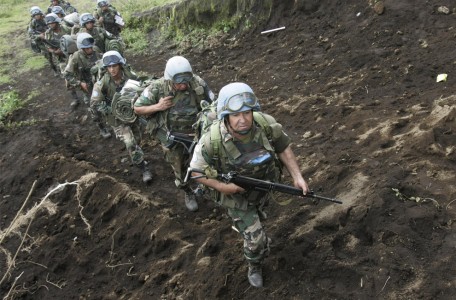For the rest of the 21st century Minerva faced increasing opposition from bandit groups, local warlords and even some city-states that managed to survive the War. While the newly formed paramilitary branch Aegis employed their Peacekeepers to defend Minerva’s territory, there was a recognized need to pursue peaceful resolution to their problems.
Aegis - Part 1
The history of Aegis is actually quite interesting. In the early days after the War, when the Long Winter first began to abate, Minerva faced few military or political threats. The few survivors they encountered were so weak from malnutrition and radiation poisoning that they couldn’t have posed a serious danger even if they had tried. No, it wasn’t until later, when Minerva expanded its territory that they first began to encounter armed competitors.
Related posts:
- Oculus - Part 1 For the rest of the 21st century Minerva faced increasing opposition from bandit groups, local Read more...
- Glaucus - Part 1 Being a product of the traditions and mentality of Glaucus, it should be of no Read more...
- Holy Fire Plague What have we done?! The purpose of Project Wormwood was to develop antidotes and treatments Read more...
Nuclear Taboo
The historical record is full of references to nuclear weapons and nuclear power, yet I cannot find any current Glaucus projects exploring the potential of atomic and nuclear research. When I asked my superior why this is so, she merely smiled and told me to figure it out myself. I think I have.
The first reason has to do with the shifting public opinion that occurred following some pre-War nuclear disasters. The Fukushima Daiichi nuclear disaster is an excellent example of this.
On 11 March 2011 a magnitude 9.0 earthquake struck off the coast of Japan, followed by a tsunami that slammed the country’s eastern coast, destroying communities and taking the lives of tens of thousands of people. The event led to the biggest nuclear disaster since Chernobyl in 1986. It also exposed serious failures in the Japanese system for ensuring the safety of nuclear reactors.
The earthquake caused the loss of external power at the Fukushima Daiichi nuclear power plant, a site with six reactors. The subsequent tsunami flooded the plant’s back-up diesel generators, causing complete loss of power and leading to a failure of the cooling systems. Due to the lack of cooling, the nuclear fuel was damaged and melted in reactors #1, #2 and #3. The build-up of hydrogen gas due to the damaged fuel resulted in hydrogen explosions in these three units and damaged the containment structure in reactor #4.
…
Outside Japan, the effects of the disaster were felt around the world. Many nations re-evaluated the ability of their own nuclear reactors to withstand natural disasters. Germany has shut down some of its reactors and has vowed to abandon nuclear energy entirely.
The Fukushima disaster raised serious questions about the myth of nuclear safety. In Japan, it revealed considerable corruption in the nuclear power sector, including efforts to mislead the public, as well as repeated examples of cronyism between power companies and the government agencies that regulate them.
Public support for nuclear power in Japan has largely eroded. Currently, over 90% of Japan’s 54 reactors are offline. All could by offline by May 2012, if none is restarted. Many local government officials have said they will not grant approval for restarting reactors. Contrary to the cries of the nuclear industry, there have been no significant problems with the electricity supply, and Japan has shown that it can survive without nuclear power.
- Fukushima Nuclear Crisis, February 2012, Greenpeace.
Even before the War and the horrible effects of nuclear weapons, nuclear power had already become anathema. All of the European Union soon followed Germany’s lead, disavowing nuclear power and research. In the course of a few years the rest of the world followed suit, until only the United States, Russia, China and a few countries trying to prove themselves, like North Korea and Pakistan, had active nuclear programs. Even then, rallies and protests against their nuclear power plants were widespread. Their was even an attempted bombing of the Palo Verde Nuclear Generating Station in the state of Arizona in the US. Sadly, the taboo against nuclear energy would not be enough to prevent the use of nuclear weaponry that caused the Long Winter.
I now understand why nuclear research stopped. I do not understand why Glaucus has never undertaken any research on nuclear energy. I can’t even find reference to any projects to clean up residual radiation in the environment, yet it is almost common knowledge that one of Minerva’s first missions was to clean the air and water around the base of radioactive particles to permit farming. Instead, I find a suspicious absence of any entry mentioning nuclear energy. Interesting. I shall have to investigate this further.
Related posts:
- Prelude to The War: The Middle Eastern Oil Crisis - Part 2 Oil Industry The background radiation levels were high enough that no one wanted to risk Read more...
- The Rebirth - Part 1 Some historians may write of 2020s as a decade of death, destruction and war, and Read more...
- Prelude to The War: The Middle Eastern Oil Crisis - Part 1 Humans can be so irrational sometimes. They overreact to things and then can’t handle the Read more...
My recent research on the use of biological weapons at Nagasaki spurred my interest on the role the BCL played in pre-War science, politics, and the later founding of Minerva. It is clear to me that they developed and produced many more biological weapons in the decades following World War II.
Many of the casualties of the Vietnam War attributed to battles, bombing and disease were actually victims of extensive biological warfare. The horrific results of these atrocities led to the signing of the 1972 Biological Weapons Convention, outlawing the development and use of all biological weapons. The BCL lost its funding soon afterward and was shut down in 1974. In the official record, the story of the BCL ends there. My personal research has uncovered, however, that many of their top researchers were recruited by the Foundation, an apolitical secret organization, to continue their work.
The Archives are full of references to Secret Societies, both real and imagined. Apparently this was an issue of much interest among pre-War peoples, for there were even many sociologists who studied the unfounded beliefs in conspiracies and secret groups plotting to take over the world. How ironic that the one secret organization to escape detection was one of the only ones completely uninterested in world domination.
The Foundation, inspired by and named after the works and ideas of author Isaac Asimov, had only one goal: to preserve the knowledge and technology of the world for the fall of civilization they believed would inevitably come. Established after the terrors of World War II, the Foundation constantly sought out scientists and researchers who shared their distaste for politicians and militaries interfering in the pursuit of knowledge. After decades of the recruitment, the Foundation had a veritable army of researchers developing technological advancements well beyond the scope of their peers constrained by government grants and approval.
In the years leading up to and during the War, while many pundits prophesied that soon all would be well again, the Foundation had prepared itself for the worst. When the dust settled and the Long Winter set in, they patiently waited, knowing that in time, they would be able to lead forth in a glorious Rebirth.
-An excerpt from Diego S. Cervantez’ seminal work, Minerva’s Origins: The Foundation, circa 2087.
It is unclear when the name Minerva was adopted, but the principles and ideals of the Foundation have managed to live on. As advanced as our technology and research has become, there continues to be a general distaste for warfare and an abhorrence of weapons of mass destruction. It was only when the situation grew exceedingly bleak that Glaucus’ researchers finally deigned to develop improved weapons and technology for Aegis’ soldiers. Even now, they do so with little pleasure.
Related posts:
- Glaucus - Part 1 Being a product of the traditions and mentality of Glaucus, it should be of no Read more...
- Minerva - Part 1 I previously wrote that it was unclear when our organization switched names from The Foundation Read more...
- The Rebirth - Part 1 Some historians may write of 2020s as a decade of death, destruction and war, and Read more...
I have been informed that the format of my research leaves something to be desired, and that I should try to quote less and share my own thoughts more. It’s not a requirement though, and this is my personal research, so I’ll continue as I please. It’s more efficient to to link to the source data directly, and prevent the duplication of existing data within our Archive.
Related posts:
- The Foundation My recent research on the use of biological weapons at Nagasaki spurred my interest on Read more...
- Holy Fire Plague What have we done?! The purpose of Project Wormwood was to develop antidotes and treatments Read more...
- The Rebirth - Part 1 Some historians may write of 2020s as a decade of death, destruction and war, and Read more...
Set in 22nd century Earth, over 100 years after the 3rd World War, the Demon Archives tells the survivors' stories as they struggle to rebuild civilization. In Book One, we'll meet the members of Minerva, one of the few high tech organizations that survived the War, and learn how they established a beacon of hope in the dreary wasteland of central Asia.
Minerva: Book One of the Demon Archives follows the story of Tenzin, a Minervan soldier, and his Oracle AI, Jane, as they fight to protect the ideals Minerva stands for in an increasingly chaotic world.
With a heavy basis in real science and technology with a healthy dallop of imagination, The Demon Archives will show you how life could be in a post-apocalyptic Earth.




